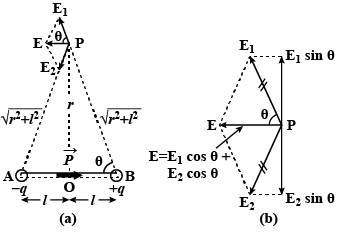
Derive an expression for intensity of electric field at a point broadside position or an equatorial line of an electric dipole.
Answer
596.7k+ views
Hint – In order to solve this problem draw the diagram of the dipoles and use the formula of electric field for a point of charge. Doing this will solve your problem.
Formula used – E = $\dfrac{q}{{4\pi { \in _0}{r^2}}}$
Complete Step-by-Step solution:

Now, suppose that the point P is situated on the right-bisector of the dipole AB at a distance r metre from its mid-point 0 (Fig. (a)]
Again,
Let ${E_1}$ and ${E_2}$ be the magnitudes of the intensities of the electric field at P due to the charges +q and −q of the dipole respectively.
The distance of P from each charge is $\sqrt {{r^2} + {l^2}} $.
Therefore,
${E_1} = \dfrac{{1(q)}}{{(4\pi { \in _0})({r^2} + {l^2})}}$ away from +q
The magnitudes of ${E_1}$ and ${E_2}$ are equal (but directions are different).
On resolving ${E_1}$ and ${E_2}$ into two components parallel and perpendicular to AB, the components perpendicular to AB (${E_1}\sin \theta $ and ${E_2}\sin \theta $) cancel each other
(because they are equal and opposite), while the components parallel to AB
(${E_1}\cos \theta $ and ${E_2}\cos \theta $), being in the same direction, add up [Fig. (b)]. Hence the resultant intensity of electric field at the point P is
E =${E_1}\cos \theta $ + ${E_2}\cos \theta $
E = $\dfrac{{1(q)\cos \theta }}{{(4\pi { \in _0})({r^2} + {l^2})}} + \dfrac{{1(q)\cos \theta }}{{(4\pi { \in _0})({r^2} + {l^2})}}$
E =$\dfrac{{2q\cos \theta }}{{(4\pi { \in _0})({r^2} + {l^2})}}$
But 2ql=p (moment of electric dipole)
Then E = $\dfrac{p}{{(4\pi { \in _0}){{({r^2} + {l^2})}^{\dfrac{3}{2}}}}}$
The direction of electric field E is 'antiparallel' to the dipole axis.
If r is very large compared to $2l\,(r > > 2l)$, then ${l^2}$ may be neglected in comparison to ${r^2}$.
E= $\dfrac{p}{{4\pi { \in _0}{r^3}}}$ Newton/Coulomb is the required electric field.
Note – To solve this problem we need to know that the electric field due to a point charge at a distance r from the charge can be written as $\dfrac{q}{{4\pi { \in _0}{r^2}}}$. Here we have resolved the components of the electric field and then add up the electric field’s components in the direction of the resultant vector and get the value of the electric field due to the dipole. As dipole contains +q and –q so due to that electric field in opposite directions cancels out since they are of equal magnitude but of opposite signs. Knowing all these things will solve your problem.
Formula used – E = $\dfrac{q}{{4\pi { \in _0}{r^2}}}$
Complete Step-by-Step solution:

Now, suppose that the point P is situated on the right-bisector of the dipole AB at a distance r metre from its mid-point 0 (Fig. (a)]
Again,
Let ${E_1}$ and ${E_2}$ be the magnitudes of the intensities of the electric field at P due to the charges +q and −q of the dipole respectively.
The distance of P from each charge is $\sqrt {{r^2} + {l^2}} $.
Therefore,
${E_1} = \dfrac{{1(q)}}{{(4\pi { \in _0})({r^2} + {l^2})}}$ away from +q
The magnitudes of ${E_1}$ and ${E_2}$ are equal (but directions are different).
On resolving ${E_1}$ and ${E_2}$ into two components parallel and perpendicular to AB, the components perpendicular to AB (${E_1}\sin \theta $ and ${E_2}\sin \theta $) cancel each other
(because they are equal and opposite), while the components parallel to AB
(${E_1}\cos \theta $ and ${E_2}\cos \theta $), being in the same direction, add up [Fig. (b)]. Hence the resultant intensity of electric field at the point P is
E =${E_1}\cos \theta $ + ${E_2}\cos \theta $
E = $\dfrac{{1(q)\cos \theta }}{{(4\pi { \in _0})({r^2} + {l^2})}} + \dfrac{{1(q)\cos \theta }}{{(4\pi { \in _0})({r^2} + {l^2})}}$
E =$\dfrac{{2q\cos \theta }}{{(4\pi { \in _0})({r^2} + {l^2})}}$
But 2ql=p (moment of electric dipole)
Then E = $\dfrac{p}{{(4\pi { \in _0}){{({r^2} + {l^2})}^{\dfrac{3}{2}}}}}$
The direction of electric field E is 'antiparallel' to the dipole axis.
If r is very large compared to $2l\,(r > > 2l)$, then ${l^2}$ may be neglected in comparison to ${r^2}$.
E= $\dfrac{p}{{4\pi { \in _0}{r^3}}}$ Newton/Coulomb is the required electric field.
Note – To solve this problem we need to know that the electric field due to a point charge at a distance r from the charge can be written as $\dfrac{q}{{4\pi { \in _0}{r^2}}}$. Here we have resolved the components of the electric field and then add up the electric field’s components in the direction of the resultant vector and get the value of the electric field due to the dipole. As dipole contains +q and –q so due to that electric field in opposite directions cancels out since they are of equal magnitude but of opposite signs. Knowing all these things will solve your problem.
Recently Updated Pages
Two men on either side of the cliff 90m height observe class 10 maths CBSE

What happens to glucose which enters nephron along class 10 biology CBSE

Cutting of the Chinese melon means A The business and class 10 social science CBSE

Write a dialogue with at least ten utterances between class 10 english CBSE

Show an aquatic food chain using the following organisms class 10 biology CBSE

A circle is inscribed in an equilateral triangle and class 10 maths CBSE

Trending doubts
Why is there a time difference of about 5 hours between class 10 social science CBSE

Write a letter to the principal requesting him to grant class 10 english CBSE

What is the median of the first 10 natural numbers class 10 maths CBSE

The Equation xxx + 2 is Satisfied when x is Equal to Class 10 Maths

Which of the following does not have a fundamental class 10 physics CBSE

State and prove converse of BPT Basic Proportionality class 10 maths CBSE




